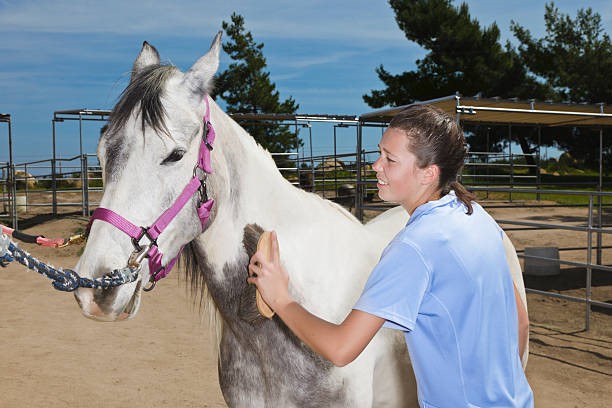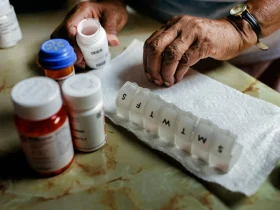Recovery from mental health challenges can be a long and complex journey, and for many people, traditional therapy might not feel like the right fit. That’s where alternative methods like horse-assisted treatment come in. Working with horses during therapy has shown incredible benefits for those recovering from mental health conditions such as anxiety, depression, trauma, and addiction.
Executive Summary
Horse-assisted treatment is a form of therapy where individuals engage with horses as part of their mental health or addiction recovery process. Horses, with their keen sensitivity to human emotions, provide non-judgmental feedback, helping people become more aware of their feelings and behaviors. This type of therapy supports emotional healing, builds self-confidence, and helps individuals develop critical coping skills, making it an increasingly popular option for those seeking alternative or complementary therapies for mental health recovery.
What is Horse-Assisted Treatment?
Horse-assisted treatment, also known as equine-assisted therapy, involves structured interactions with horses to address emotional, psychological, and behavioral issues. These sessions can include activities like grooming, feeding, leading, and even riding horses under the supervision of a licensed therapist. The focus isn’t on learning to ride, but rather on fostering emotional connections, improving communication skills, and developing coping mechanisms.
What makes horse-assisted treatment stand out is the unique relationship between horses and humans. Horses are incredibly intuitive animals that can sense and respond to human emotions. Their non-verbal communication offers immediate feedback, helping individuals better understand their internal states. This dynamic makes horse-assisted treatment particularly effective for people who may have difficulty expressing their emotions in traditional talk therapy settings.
How Does Horse-Assisted Treatment Support Recovery?
The road to recovery is rarely linear, and each person’s journey is different. However, horse-assisted treatment offers a variety of benefits that support recovery on multiple levels—emotionally, physically, and mentally.
1. Emotional Awareness and Regulation
One of the most significant ways that horse-assisted treatment supports recovery is by increasing emotional awareness and helping individuals regulate their feelings. Horses are highly sensitive to the emotions of those around them. If someone is feeling anxious or upset, the horse will react accordingly. This real-time feedback can help individuals recognize emotions they might otherwise suppress or overlook. Over time, they can learn how to manage these emotions more effectively, leading to improved emotional regulation—a critical skill in recovery.
2. Building Trust and Relationships
For many people in recovery, whether from trauma, addiction, or mental illness, trust can be a significant barrier. Past experiences may have made it difficult to trust others or to form healthy relationships. Horses, being large and powerful animals, require trust in order to engage in safe and meaningful interactions. Developing trust with a horse can translate into improved relationships with others, both in personal and therapeutic contexts. It teaches individuals the importance of trust, patience, and consistency—all valuable lessons in recovery.
3. Boosting Self-Confidence and Empowerment
Recovery often involves rebuilding a sense of self-worth and confidence. Working with horses can be an empowering experience, particularly for individuals who may feel powerless in other areas of their lives. Successfully interacting with and caring for a horse—an animal much larger and stronger than a human—can instill a sense of accomplishment and boost self-esteem. This newfound confidence can carry over into other areas of life, making it easier to face challenges with resilience and optimism.
4. Encouraging Mindfulness and Presence
Horses live in the moment and require the people working with them to do the same. Being fully present while engaging with a horse is crucial for safety and communication. This mindfulness practice can help individuals in recovery stay grounded and focus on the present, rather than getting lost in past traumas or future anxieties. Practicing mindfulness with horses can teach individuals how to carry that same presence into their everyday lives, supporting their mental health recovery long after the therapy session has ended.
5. Non-Verbal Healing
Not everyone feels comfortable verbalizing their emotions, especially when dealing with trauma or deep-seated emotional pain. Horse-assisted treatment offers an alternative way to express feelings and heal without having to put everything into words. Horses communicate through body language and energy, making them excellent partners for individuals who may struggle with traditional forms of communication. This non-verbal interaction allows individuals to process emotions in a way that feels less intimidating and more natural.
Who Can Benefit from Horse-Assisted Treatment?
Horse-assisted treatment is a versatile form of therapy that can benefit a wide range of individuals. Some of the most common conditions that can be supported through this type of therapy include:
Anxiety and Depression: Horses can help individuals become more aware of their emotional states and provide a calming influence, making it easier to manage symptoms of anxiety and depression.
Post-Traumatic Stress Disorder (PTSD): For trauma survivors, particularly those dealing with PTSD, horses offer a non-judgmental and safe space to rebuild trust and process difficult emotions.
Substance Abuse and Addiction Recovery: Horse-assisted treatment is often used in addiction recovery programs. The therapy helps individuals develop emotional regulation, responsibility, and confidence, which are key elements in overcoming addiction.
Children and Adolescents: Kids and teens, especially those with behavioral issues or developmental disorders, can benefit from the non-verbal and interactive aspects of horse-assisted treatment.
Individuals with Autism: Equine therapy has been shown to help individuals on the autism spectrum improve their communication and social skills through interactions with horses.
A Typical Horse-Assisted Therapy Session
Wondering what happens during a horse-assisted treatment session? Typically, sessions take place outdoors in a stable or farm setting. The therapist, the client, and the horse work together on various activities designed to foster emotional connection and personal growth.
Some activities might include grooming the horse, leading the horse through an obstacle course, or even just observing the horse’s behavior. These activities are often followed by reflective conversations with the therapist, helping the client draw connections between their experiences with the horse and their emotional or behavioral patterns.
One of the best aspects of horse-assisted treatment is that it’s highly adaptable. The activities can be tailored to fit the client’s specific needs and goals, making it an excellent option for people who may not respond to traditional forms of therapy.
The Science Behind Horse-Assisted Treatment
The therapeutic benefits of working with horses aren’t just anecdotal; they’re backed by research. Studies have shown that interacting with horses can reduce stress levels, lower blood pressure, and improve mood. Working with animals has also been shown to increase the release of oxytocin, the “feel-good” hormone, which can help individuals feel more connected and supported.
For individuals in recovery, these physiological benefits can be incredibly valuable. Reducing stress and anxiety, increasing emotional awareness, and building a sense of connection can all contribute to long-term recovery success.
FAQs About Horse-Assisted Treatment
Q: Do I need to have experience with horses to participate in horse-assisted treatment?
A: No, prior experience with horses is not necessary. A licensed therapist will guide you through all interactions, ensuring both your safety and the horse’s well-being.
Q: Is horse-assisted treatment safe?
A: Yes, horse-assisted treatment is safe when conducted by trained professionals. The horses used in therapy are specifically chosen for their calm and patient nature, and sessions are carefully supervised.
Q: Can horse-assisted treatment be used alongside traditional therapy?
A: Absolutely. Horse-assisted treatment is often used as a complementary therapy alongside traditional methods like talk therapy or cognitive behavioral therapy. It provides an additional layer of emotional and psychological support.
Q: How long are horse-assisted therapy sessions?
A: Sessions usually last about 45 minutes to an hour, though the duration can vary depending on individual needs and therapeutic goals.
Q: What if I’m afraid of horses? Can I still participate?
A: Fear of horses is a common concern, but therapists will work at your pace to ensure you feel comfortable. You won’t be forced into any interactions that feel overwhelming, and the goal is to help you build confidence gradually.
In conclusion, horse-assisted treatment offers a unique and powerful way to support recovery from a wide range of mental health challenges. Whether you’re dealing with trauma, addiction, anxiety, or depression, working with horses can provide emotional healing, build trust, and foster self-awareness in ways that traditional therapy might not. If you’re looking for an alternative form of therapy that connects you with nature, animals, and yourself, horse-assisted treatment could be the answer you’ve been searching for.









Leave a Reply
View Comments